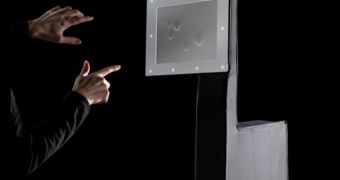Last week, in Geneva, the world saw a new brand of computers, one that is entirely operated via gestures and that has no keyboard or mouse attached to it. In addition, it also has a twisting neck, which allows it to follow the motions of its users. Otherwise explained, if you stand on your feet in front of it and move to either side, it will always face you. Plus, you can also play games such as tennis on it, using only your hands. If two people play, it will rotate from one to the other, so that each of them can get the best view of the playing filed possible.
The main drawback of current computers, the thing that has made Swiss Federal Institutes inventor Frederic Kaplan think of the new design in the first place, is that users have to generally sit when interacting with them, and to use both their hands to perform the tasks. Also, a great degree of concentration is required in order to operate them. The regular type of interface, featuring a keyboard and a mouse, means that people generally need to keep their hands clean in order to prevent contamination.
This, of course, indicates that they cannot be used while cooking or repairing a car. The new design, named QB1, is perfect for such situations, its creators say, as it doesn't require all that much concentration on the part of the user in order to operate it. Plus, the robotic neck is a welcome addition to the new machine's built-in features. It basically acts like a person, always seeking eye contact with the individual operating it, thus making it very easy to work
The hand and arm gestures that are used as an input are also visible on the screen of the computer, so that you can know exactly how it interprets your movements and figure out if it does so properly. It detects these movements via a small camera that is incorporated into the screen. To put things into perspective, the computer acts like a remotely-operated touchscreen. But, unlike these devices, it can also map a 3D area of the room, to gain an understanding of the distance users are located from it.
This allows QB1 to vary the size of the text it displays on the screen, so as to make it more readable, even from long distances. Researchers have included in this project the plan to give some of these computers away for home-testing in the future, to selected users. “These trials in real contexts are essential to turn QB1 into a real product. We wish to attract very different profiles of users, hopefully from different countries and cultural backgrounds,” Kaplan concludes.

 14 DAY TRIAL //
14 DAY TRIAL //